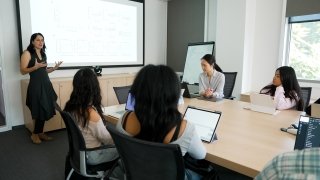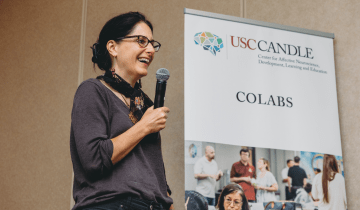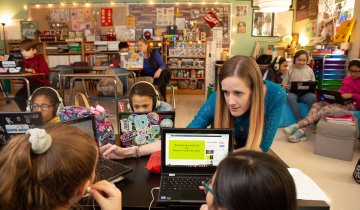Integrating research-backed methods into teaching is essential for educators who are looking to better serve the needs of their students. But with their busy schedules, teachers often don’t have time to read academic papers on the latest education research. Researchers at USC Rossier study education from a variety of perspectives, and they are actively working to develop pathways so that this cutting-edge research can make it to the place where it matters most: the classroom.
USC Rossier professor Mary Helen Immordino-Yang and her colleagues at the USC Center for Affective Neuroscience and Developmental Learning and Education (USC CANDLE) published a landmark study in 2024 that, for the first time, showed a link in what they describe as transcendent thinking and brain growth in teens. These findings could have a huge impact on how we educate, and for Immordino-Yang, the next challenge is developing how best to integrate these concepts into our schools.
Changing the way a lesson is taught can feel daunting, but Immordino-Yang and her colleagues argue that it takes a shift in how we think about and approach teaching. To start, let’s define a few key terms from Immordino-Yang’s research:
Transcendent thinking moves beyond reacting to the concrete specifics of social situations to also consider the broader ethical, systems-level and personal implications at play. Engaging in this type of thinking involves analyzing situations for their deeper meaning, historical contexts, civic significance and/or underlying ideas. Transcendent thinking might take the form of recalling personal experiences, reflecting on one’s beliefs and values and experiencing feelings of compassion and gratitude.
Civic reasoning rigorously examines available evidence and multiple perspectives around meaningful personal and social issues. Civic reasoning is dependent upon transcendent thinking.
Immordino-Yang’s research shows that teens with a disposition to more readily engage in transcendent thinking and civic reasoning show patterns of brain growth related to a stronger sense of self and satisfaction in life. Her team is also studying how this disposition can be fostered in schools.
While “educating for dispositions of mind is not new,” Immordino-Yang explains in a 2020 article for the Association for Supervision and Curriculum Development (ASCD), what is new is “tying these dispositions to neural development, life success and mental health.” And, most importantly, educators can learn how to support transcendent thinking and civic reasoning in their classrooms.
To see these principles in action, we can turn to a few quotes from Los Angeles-area teens who participated in Immordino-Yang’s study. The teens were asked to explain why they thought individuals in their communities commit violent crimes. Compare the first set of quotes (A), with the second set of quotes (B):
(A)
“Why does it happen? Because they take actions or do things that don’t benefit them. They just get caught up in the moment…”
“I guess it’s just bad decisions that they make and they have to suffer the consequences.”
“They have, like, a lot of emotions. They’re really mad so they just kill somebody. Like, overly aggressive, yeah…”
(B)
“… _[Violence] is a cycle. Like if you really look at it … it happens probably because their family is in a gang and they just follow it ‘cause that’s their role models, where they came from…”
“Everyone has a history. Like, everybody has an action or a choice, or some sort of history, some sort of thing happened to them that affects how they act in the future…”
“… Because many people say how Watts [a Los Angeles neighborhood] is really bad, and sometimes people who live there believe it, so they start doing the bad things [people] say they probably do… I think, like, people do what other people think they do.”
In the first set of quotes, Immordino-Yang explains, the teens are reflecting on the immediate reasons for these violent acts, but in the second set of quotes, the teens thinking suggest an awareness that these crimes don’t happen in a vacuum but are part of “a complex personal and community ‘history,’ a ‘cycle’ that is perpetuated by relationships, expectations and what people come to ‘believe.’ This type of thinking is transcendent according to Immordino-Yang, and the reasoning on display is civic.
The benefits of civic reasoning extend beyond the individual. Immordino-Yang explains in a recent paper that “civic reasoning is among the most important capacities youth must develop to sustain a functioning and equitable democratic society, and hence should be among the central aims of education.”
It’s also important to note that teen brains are undergoing many changes, and their brains are what neuroscientists would call “plastic,” or malleable, meaning the ways they use their brain can help strengthen neural pathways which can lead to all sorts of benefits for them later in life, as Immordino-Yang’s research has shown.
Teens are not only interested in the big questions they grapple with when they are engaging in civic reasoning—they are primed for them. During adolescence, they are exploring the world around them and what it means for them to be a person in this world. But school assignments and classroom activities often focus on rote memorization with a hyper-emphasis on standardized testing, which can leave teachers with little time to integrate activities that allow for open-ended thought and explorations.
Bringing transcendent thinking and civic reasoning into the classroom
So, how can educators create opportunities for adolescents to flex their mental muscles in ways that feel both organic and authentic to their students?
To create classrooms that can foster transcendent thinking and civic reasoning, Immordino-Yang and her colleagues urge educators to situate daily lessons in the classroom in larger contexts that relate to students’ lives, experiences, values, identities and possible futures. By doing this, students can more deeply engage in the content.
For example, even in math class, it is possible to bring in civic reasoning skills.
Immordino-Yang suggests a classroom activity for high school math students in which they are asked to apply statistical methods they learned to a social issue, like income and wealth distribution.
“They analyze trends over time and look at variables such as geographic location and workers’ rights laws in different states, as well as people’s education levels, gender, race and ethnicity,” Immordino-Yang explained in a recent commentary for the Brookings Institute. “They present and debate what they find, which leads to deeper discussions about the values and intentions behind policies,” Immordino-Yang says.
Another example Immordino-Yang suggests is connecting students with those they perceive as different from them. For example, middle schoolers from an urban location like New York City could exchange letters or emails and meetup via video chats with students from rural Virginia. “As they learn about each other’s daily lives, they begin to see how what are described as “blue” and “red” communities in this country are similar and how they are different. By the end of the unit, they have read common texts and critically explored their perspectives on a topic that is important to them, such as gun rights,” Immordino-Yang says.
Forging a new path
One of the largest barriers to integrating civic reasoning and transcendent thinking into classrooms “is the core mismatch between students’ developmental needs and traditional schooling,” Immordino-Yang says. But despite this hurdle, many educators are finding ways to bring these concepts into their classrooms and Immordino-Yang’s research is helping to show how essential this shift in educating our youth is for not only their development, but also for the greater good of our society.
And this shift doesn’t have to be laborious as teachers might fear.
With the launch of the USC CANDLE Innovation Lab, Immordino-Yang and the USC CANDLE team will bring together researchers, educators, administrators and students in a collaborative setting to integrate their research into classrooms around the nation. The USC CANDLE Innovation Lab will explore how understanding adolescent brain development can revolutionize teaching methods and will guide educators and administrators at partner schools as they implement these methods in their classrooms.
The aim of the USC CANDLE Innovation Labs not to present teachers with a curriculum to implement but to support teachers as they design learning experiences that integrate concepts like transcendent thinking and civic reasoning. “This initiative has the potential to reshape not only how teachers approach learning but also how students see themselves and their futures,” says Immordino-Yang.





